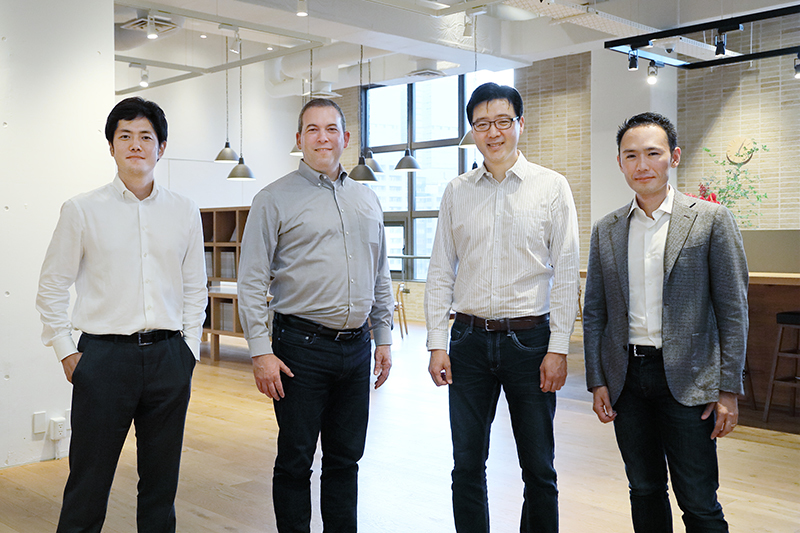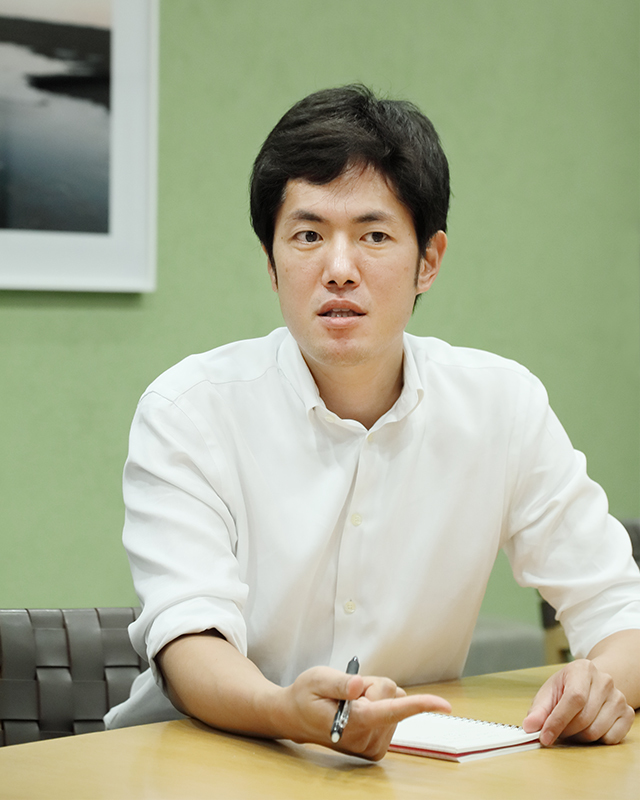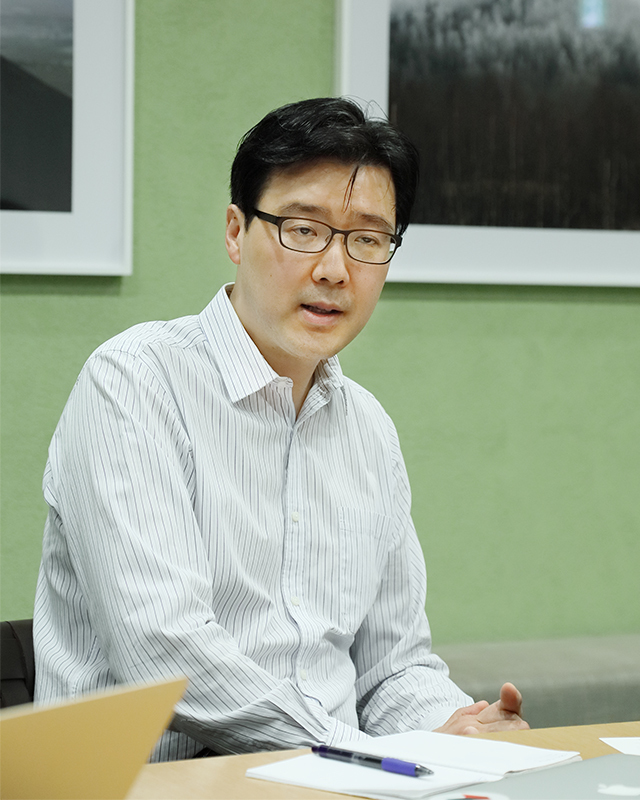Content marketing involves proactively providing content through owned media and other channels to build lasting relationships with consumers. While it has been a hot topic in Japan for several years as a new trend in digital marketing, as mentioned in another article, there remains a lack of recognition regarding its fundamental perspective: its contribution to business.
Four experts discussed this theme: Charles Huff, Senior Vice President of NewsCred (which entered the Japanese market in partnership with the Amana Group this July); Yaron Galai, founder of Outbrain; Hiroshi Shimose of Outbrain Japan; and Keigo Aoki of Dentsu Inc. Business Creation Center.

From left: Hiroshi Shimase, Yaron Galai, Charles Huff, Keigo Aoki
Hiroshi Shimose(hereafter Shimose): In the world of content marketing, we believe "Content is King, Distribution is Queen." Neither can exist without the other. The idea that if you create good content, people will come to see it is becoming less effective for Millennials, whose content consumption behavior has changed significantly from previous generations. Therefore, planning how to effectively deliver that content must be considered simultaneously. This point is gradually gaining recognition among Japanese marketers as well.

Hiroshi Shimose
Charles Huff (Charles) : The crucial point is that content creators shouldn't become artists or creators per se. While great content is vital, it's just one piece. You need to combine these pieces to create the whole. This fusion of art and science is the core of what we advocate as "scientific content marketing." Rather than creating content first and then figuring out delivery later, we must proactively consider what strategy to adopt, what kind of content to create, and how to deliver it to reach the right people. This approach also leads to the correct selection of content and topics. Naturally, all actions are deeply interconnected.

Charles Huff
Keigo Aoki (hereafter Aoki) : And the goal of "scientific content marketing" is to contribute to the business. Creating content must not become an end in itself. For example, News Credo enables a swift start to content marketing by providing licensed content.
Charles: We have contracts with approximately 5,000 publishers, including The Economist, Forbes, and The Wall Street Journal, and hold rights to over 40 million articles with copyright clearance. By providing this content, we support clients in leveraging publisher credibility to gain user engagement when branding their services on owned media. Furthermore, using licensed content generates a certain amount of traffic to your owned media, allowing you to understand the direction needed when creating original content.
Consider Netflix as an example. In the early stages of their service, they did not produce original content. Instead, they adopted a model of providing users with a large volume of licensed content—content that had already been broadcast somewhere else. By analyzing trends in content consumption, they measured factors like what kind of traffic patterns existed for different types of content, what was being watched and when, and learned what people were seeking. Building on this, they then created high-quality original content and achieved success.
Similarly, we propose leveraging licensed content to understand user behavior before introducing proprietary original content. First, deploy a large volume of licensed content that aligns with your concept to ensure overall site content volume. Then, meticulously measure site performance to identify the "missing pieces" that licensed content alone cannot fill. Finally, deploy original content in those areas where high effectiveness is expected. This approach enables the operation of a high-performing media platform.
──So by securing a certain level of traffic with licensed content and analyzing user behavior there, you can understand what direction to take with original content to gain user support. That's a real eye-opener.
Aoki: Understanding user tendencies broadly through licensed content allows us to gauge the performance of original content more accurately and visualize each piece's contribution to KPIs. While original content has high conversion potential, it also demands significant cost and time. Knowing the individual contribution of each piece enables us to strategize the optimal sequence and type of content to provide users, creating a comfortable and ideal journey.
What we expect from NewsCred is their ability to leverage their vast library of licensed content and their platform for managing and operating content performance. This enables Outbrain to determine which content should be delivered to which users. In other words, first efficiently gather high-quality content via NewsCred and distribute it to owned media. Next, by observing the performance of individual pieces of content and understanding user engagement with that content, we can grasp the optimal journey. This will then enable us to design precise content delivery plans within Outbrain as well. In this way, we believe we can build a system where clients can provide valuable content experiences for users on their owned media.

Keigo Aoki
Shimase: To add to that, we handle a tool called "TrendyMon" that allows centralized management of content's contribution to KPIs. Current analysis often focuses solely on evaluating the content that generated the last click. However, every content journey begins with content that sparks initial interest, progresses through nurturing content that drives attitude change, and ultimately leads to the final action. Without understanding these correlations, accurate content evaluation is impossible. TrendyMon visualizes this journey. By introducing their tool to clients, we aim to help them establish the right evaluation criteria for content.
Charles: We also have high expectations for Japanese publishers. That's the purpose behind partnering with Amana. This partnership allows us to introduce content from publishers worldwide to Japan, while also disseminating Japan's excellent content to countries around the world, including the US and Asia. This is one of our major visions.
──That's great news for both Japanese content marketers and publishers.
Charles: What we want to emphasize is that these activities differ significantly from traditional approaches. While the effects of campaign-based advertising are difficult to accumulate, the effects of content within "Always-On Marketing" can be accumulated. In other words, content becomes an asset for the company. Content marketing isn't something new added to traditional methods; it doesn't compete with them. Rather, it optimizes the marketing you've been doing more effectively. In that sense, we believe it represents the future of marketing itself.
──In that sense, Yaron and Charles, the content marketing you propose through your business seems like a return to the roots of marketing, or pure marketing—the very essence of marketing.
Yaron Galai (hereafter Yaron) : Before founding Outbrain, I ran a company supporting search engine marketing. Back then, even the most cutting-edge offline marketers would react with "No, that's not marketing" when told "You can advertise on search engines." Now, search engine marketing (like SEO) is commonplace. Based on that experience, I believe providing value to consumers through content will also become the norm going forward.

Yaron Galai
Charles: If we were to rename content marketing, I think we could call it authentic storytelling—true storytelling in the deepest sense. It's about marketing that stems from thoroughly examining why you offer a service or product, what its value is, and whether the brand itself can weave its own story. A brand without a story is just a product. In that sense, when you get to the core, it boils down to whether you can tell a story.
Yaron: Millennials skip and block ads in every possible way. To reach them, the only option is delivering value through the format of content. Naturally, everyone has different tastes and preferences, so a vast amount of content is needed to make them feel it's personalized for them. Moreover, it must be high-quality content capable of changing attitudes, delivered at the right moment. And this isn't some distant future scenario; it's the reality unfolding right now, at this very moment.
──In this context, News Credo seems to be advocating a concept called "presales."
Charles: That's what we call our "advisory service." When we started the business, we naturally prepared content and the platform to manage and operate it. But as we progressed, we realized content marketing isn't that simple. That's why we strengthened the advisory function.
It's self-evident that excellent strategists are crucial for content marketing. But it's not just about taking on content operations. Before accepting a project, we need to clearly define the client's KPIs for that project – in other words, we need to agree on generating the "right demand." Our pre-sales approach involves thoroughly discussing what goals we will achieve together, while ensuring the client has a proper understanding of our service capabilities.
──In Japan, it feels like an untapped area. Could Dentsu Inc. play a role in raising awareness there?
Aoki: You're absolutely right. A few years ago, when content marketing first gained attention, simply setting up owned media and starting to create content was enough to earn recognition. However, recently I've heard of cases where, when asked by management, "By the way, is content marketing actually contributing to sales?", companies struggle to provide a clear explanation. To avoid such situations, before implementing new initiatives, everyone involved must clearly agree on the ultimate goal, how specific solutions will be utilized to achieve it, and the scope and responsibilities of each relevant player. This isn't unique to content marketing; it's essential in the digital age of marketing, where performance can be meticulously visualized.
In this sense, agencies find it increasingly difficult to justify their value by merely introducing superior solutions. To put it bluntly, clients' true sentiment might be: "Thanks for showing us a good tool. We'll handle the rest ourselves." However, as Yaron and Charles mentioned, the world is plunging deeper into chaos, and we're facing a period of major transformation, including the rise of Millennials. Amidst this, what truly matters for brand marketers is the growth of their own business; digital solutions are merely the means to that end. With events unfolding at a dizzying pace and change being so rapid, is it truly beneficial for brand marketers to spend their time gathering information about these "means" or judging their merits?
We constantly update our knowledge of overseas solution trends while engaging with leading global brands and companies. Agencies like ours should not sell individual tools or features; instead, we should combine the capabilities of superior solutions, customize them for each brand company, and make proposals. Meanwhile, brand marketers should focus on what new and wonderful experiences they can provide to consumers. This is what we believe "true content marketing" should be, and we see ourselves as the ones who should accelerate this shift.
──I see. So the role of agencies in digital marketing is changing too. Thank you for today.














